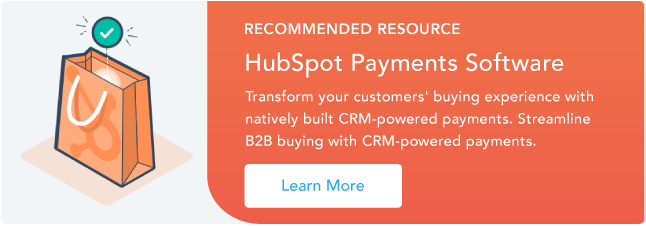How to Accept Credit Card Payments
To start accepting credit cards you only need two things: a credit card processing service and a way to collect your customer’s credit card information. Within each of these, you’ll have some choices to make – which can get a little overwhelming. To keep it easy, we’ll break down each one so that you can focus on how it fits the needs of your small business.
For a processing service, you’ll need to choose between a merchant account or a third-party payment processor (think PayPal or Square).
To collect card data, you’ll need to consider if you’ll be accepting payments online, in person, or by phone.
Let’s take a look at your choices a little more closely.
Merchant Account vs Payment Processor
The traditional way to accept credit cards is to open a merchant account with a bank or other financial institution. A merchant account is a special type of bank account that allows you to accept payments.
With a merchant account, you’ll likely have to buy your own hardware and negotiate your fees. These fees will differ based on the credit card network, card issuer, and even the method of card entry.
A faster and easier way to get started is to use a third-party payment processor – like PayPal, Stripe, or Square. You may also see them called “payment service providers” or PSPs. These service providers handle the merchant account for you and sometimes include a card reader for free. Their fees tend to be slightly higher than a merchant account, but they don’t change based on the credit card network or credit card. This makes it a little easier to understand what you’ll be paying each month.
So, how do you know which is right for you? If you have a high volume of credit card sales, negotiating your fees with a merchant account could save you money in the long run. Otherwise, most small businesses prefer the simplicity and predictability of a PSP.
How to Accept Credit Card Payments Online
To accept credit cards online you’ll need something called a payment gateway. A payment gateway is software that allows your customers to securely share their credit card information with your payment processor.
When you see a PayPal button on a website, that’s a payment gateway. When you checkout from a Shopify shopping cart, that’s also a payment gateway.

Most payment service providers include some kind of payment gateway as part of their service. This may connect to your website or link out to an off-site account portal.
Pro Tip: Many payment processors integrate with HubSpot payments. This allows your customers to make payments directly from your website. You can also create shareable payment links that can be sent by email or text, or even embedded in an invoice.
How to Accept Credit Card Payments in Person
Once you have your merchant account or payment service provider (PSP), you’ll need a way to physically collect your customers’ card information. This will look different depending on the type of business you own. Here are some options you might consider:
- Point-of-Sale (POS) System - This software can track your products, inventory, and sales history. It may include a card reader or allow you to manually enter credit card information. A POS system is a good choice for restaurants or retailers with multiple products.
- Card Reader or Terminal - This allows your customers to swipe or insert their card. It may also allow them to make contactless payments.
- Mobile Card Reader - This small device turns your smartphone or tablet into a credit card terminal. These are an excellent choice for food trucks, farmers markets, and other traveling businesses.
- QR Code - You display a custom QR code for your customers to use. Scanning it brings them to a payment app, so they can input their credit card details on their own smartphone.
Many payment service providers will include some kind of payment entry at no extra cost.
Pro Tip: Many PSPs integrate with Sales Hub, instantly connecting your customers’ purchase history to your records and reports.
How to Accept Credit Card Payments by Phone
If you want to accept credit cards through a phone call, you’ll need a point-of-sale system that allows you to manually input card details. Your customer will read off the card information while you enter it. This is called a card-not-present transaction and is common for businesses like restaurants and florists.
Be aware that card-not-present transactions will incur a higher fee because of the higher risk of fraud.
How much does it cost to accept a credit card payment?
Usually, when talking about the cost of accepting credit cards, people mean transaction fees. These are a percentage of the sale price that you pay for each transaction. Transaction fees can be confusing because they may change depending on certain factors.
With a traditional merchant account, your transaction fees may change based on:
- Credit card network (Visa, Mastercard, etc.)
- Credit card type (business, rewards, etc.)
- Method of payment (online, in-person, by phone, etc.)
According to Reuters, industry analysts put the average processing fee between 1.5 to 3.5%.
An advantage of using a PSP over a merchant account is that they typically charge a flat rate. For example, with HubSpot payments, you pay 2.9% no matter what type of credit card your customer uses.
In addition to transaction fees, there may also be setup fees, hardware costs, and monthly subscriptions. These added charges are more common with a traditional merchant account. Most PSPs don’t include these costs or will waive them as part of promotional offers.
1. HubSpot Payments: Best Overall

HubSpot payments is a frictionless payment tool that lives within your CRM. It allows you to accept all major debit or credit cards, ACH payments, and even recurring payments. It also lets you accept payments straight from your website, or create shareable payment links that you can embed in emails, text messages, and even invoices.
But the best part is that the integration with Sales Hub lets you instantly combine your sales data with your customer records and reporting.
HubSpot payments is available to U.S.-based Sales Hub users with a starter account or above. There are no added setup fees or monthly charges, and the transaction fees are a simple 2.9% flat rate.
Fees: Flat 2.9% of transaction amount
Other Costs: None
Why We Like It
- Accept credit cards straight from your website
- Send secure, shareable payment links by email or text
- Embed payment links in quotes or invoices
- Instantly connect your customers’ purchase history with your records or reporting
- Enable recurring payments and subscriptions
2. Stripe: Best for Online Payments

Stripe lets you offer flexibility with a Bluetooth card reader that handles swipe, EMV chip, and contactless card payment. It even works with Google Pay and Apple pay.
But where Stripe really excels is with online payments. Use one of its pre-built payment pages or embed its checkout cart straight into your existing website. Or, if you have a developer handy, you can customize a personal checkout cart.
Fees:
- Online: 2.9% + $0.30 per transaction
- In-Person: 2.7% + $0.05 per transaction
Other Costs: One-time fee of $59 for basic card reader
Why We Like It
- Accept swipe, chip, or contactless payments from the same card reader
- Offers a pre-built payment page for businesses who just want a fast and easy online experience
- Online experience includes 1-click payment, address auto-complete, and payment method reuse
3. Square: Best for Mobile Payments

Square offered the original mobile card reader and it’s still one of the most popular. Plug it into your phone, download the app, and you’re ready to go. Plus, your first magstripe card reader is free. You can also upgrade your card reader to accept chip cards, contactless payment, Apple Pay, or Google Pay.
But Square is not limited to mobile payment. It also offers POS software, retail registers, and manual entry options. Square even offers invoicing and appointment scheduling software. Need an online option? Square lets you add a payment portal, or build a free online store with their store builder.
Fees:
- Online: 2.9% + $0.30 per transaction
- In-Person: 2.6% + $0.10 per transaction
- Card-not-present: 3.5% + $0.15 per transaction
Other Costs: Upgrade your card reader for one-time $49
Why We Like It
- Free magstripe card reader that connects to your smartphone or tablet
- Accept payments offline when you’re without internet
- POS, card reader, register, or online options for nearly any business model
- Free online store builder
4. PayPal: Best All-In-One

You’ve definitely heard of PayPal, and so have your customers. So, whether you’re adding a PayPal button to your site, or using its card reader in your store, your customers know they can trust it.
But aside from name recognition, PayPal’s biggest strength is that it offers a wide range of payment solutions. Use PayPal on your website and you can accept credit cards, peer-to-peer payments, and even Venmo. Give your in-person customers choices with swipe, chip, contactless, or QR code payment. Track your sales history, inventory, and staff hours in the POS. No matter what kind of business you run, PayPal has something for you.
Fees:
- Online: 2.9% + $0.30 per transaction
- In-Person: 2.29% + $0.09 per transaction
- Card-not-present: 3.49% + $0.09 per transaction
Other Costs: One-time fee of $29 for card reader
Why We Like It
- Brand name recognition creates trust
- Accept peer-to-peer payments through PayPal or Venmo
- POS software lets you track inventory, sales, and even staff hours
- Leverage QR codes for fast, contactless payments
5. Shopify: Best for Ecommerce

While Shopify offers in-person and online payment solutions, its best known for its ecommerce platform. If you need a website, Shopify offers a drag-and-drop store builder with its built-in checkout cart. Or, if you need to monetize your existing website, Shopify lets you easily add product cards and a buy now button.
But what if you have a website and a retail store? Shopify’s POS system lets you connect both. This lets you streamline your sales process for your customers and your business. It also lets you offer handy options like in-store pickup from online purchases. Using the best-listed POS system allows your company to accept payments from customers and keep track of sales. The setup can vary depending on whether you sell online, have a physical storefront, or both.
Fees:
- Online: 2.9% + $0.30 per transaction
- In-Person: 2.4% of transaction amount
- Card-not-present: 2.9% + $0.30 per transaction
Other Costs: Starts at $29/mo.
Why We Like It
- Connect your in-store and online business
- Drag-and-drop store builder
- Card-not-present fees are the same as online payment fees
Frequently Asked Questions About Credit Card Payments
Can I accept credit card payments as an individual?
Individuals can use a payment processor like PayPal, Stripe, or Square to accept credit cards even if they don’t have a registered business.
Can I use PayPal to accept credit card payments?
In addition to peer-to-peer payments, PayPal allows you to accept credit cards online, in person, or by mobile app. PayPal works with all major credit card brands, including Mastercard, Visa, and American Express.
Can I accept credit cards through Venmo?
Venmo can’t be used to accept credit cards as a payment processor. You can use a credit card to make a peer-to-peer payment on Venmo, but it will incur a 3% processing fee and extra cash advance fees.
What is the cheapest way to take card payments?
For most small businesses, the cheapest way to take card payments is to use a third-party payment processor. While the transaction fees may be slightly higher, you’ll skip the monthly charges, hardware costs, and setup fees.
For businesses that have a high volume of credit card sales each month, it may be cheaper to negotiate your transaction fees with a merchant account.
How can I accept credit card payments for free?
There’s no way to accept credit cards without transaction fees, but you can avoid monthly costs and hardware fees. You may also be able to use software to accept online payments for free.
Can I accept credit card payments without a merchant account?
A payment processor like Square or PayPal allows you to accept credit cards without a merchant account. These third-party services handle the merchant account and processing for you.
Get Started With Credit Card Payments
Customers are using credit and debit cards more and more. By accepting credit cards you make it easier for them to use the payment method they prefer. No matter which payment processor you choose, you’ll stop leaving money on the table, and start putting it in your pocket.
Payments





![All Types of Payment Methods Business Owners Need to Know [+Data]](https://53.fs1.hubspotusercontent-na1.net/hubfs/53/typesofpayment.webp)
.webp)


![ACH API: What it is + How to Use it [+ Who Should Not]](https://53.fs1.hubspotusercontent-na1.net/hubfs/53/ach-api.jpg)
![What is ACH credit [+ Is It Safe to Use?]](https://53.fs1.hubspotusercontent-na1.net/hubfs/53/what-is-ach-credit.jpg)

